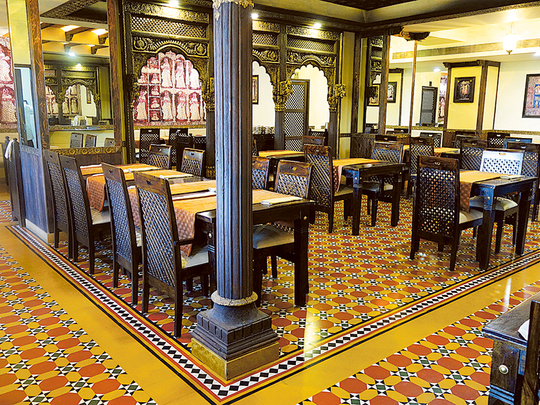
You can’t be blamed if a meeting with the Variavas leaves you floored. After all, this Mumbai family has, for generations, been the name behind tiles that grace the floors of several of India’s iconic buildings — tiles that take you back to an elegant past and tiles that offer a glimpse of a chic future.
Much before the world woke up to the charm of the old and the beautiful, Dilnavaz Variava had already begun reviving the beauty of the traditional craft of tile making. The non-executive chairperson of Bharat Floorings and Tiles (BFT) in Mumbai, Dilnavaz says, “Every Mumbaikar [resident of Mumbai] has walked on a ‘Bharat’ floor, knowingly or unknowingly — and non-Mumbaikars too — for our tiles were laid in the governor’s Raj Bhavan and in palaces that are now some of India’s most iconic hotels. Mahatma Gandhi and US President Barack Obama are just two examples of those who have walked on the floors that are now 93 years old.”
Owners of this pioneering handmade and made-to-order cement tile company, the Variavas are a rare breed of people who are trying to revive heritage tiles that cover nearly a century of architectural styles. Dilnavaz and her son Firdaus have been producing handmade tiles reminiscent of British-era government buildings and the palaces of maharajas, to the Art Deco and modern, and in doing so are awakening people’s cultural consciousness.
Their commitment stems from a singular belief: the floor of a building is one of its most important and lasting features and gives a clear indication about the period the building was constructed in, and by extension, earns its rightful place in the country’s architectural evolution.
In a rare case of a corporate wanting to safeguard their legacy, Firdaus, vice-chairman of BFT and third generation owner, says, “Being relevant in today’s world is a challenging job involving collaborations with artists and designers to stay in tune with trends. We are no longer viewed only for our heritage-linked past, but for also our chic and modern designs.”
With people rediscovering the charm of tiles and what they can do to enhance the look of a place, these square pieces of art have become a design statement. The Variavas have laid intricate flooring for many of Mumbai’s structures, including the Dr Bhau Daji Lad Museum, which was honoured with the Award of Excellence by Unesco for conservation of heritage in 2005, as well as the Royal Bombay Yacht Club. Other prominent buildings that their works grace are the Mumbai Central Station, Chhatrapati Shivaji Terminus, the 123-year-old Brihanmumbai Municipal Corporation headquarters and the Bombay High Court.
Dilnavaz’s tryst with heritage flooring began early. She was mesmerised by the beautifully patterned and vibrantly coloured tiles in her own home and other buildings in Mumbai.
Even though Dilnavaz retired a couple of years ago, handing over the reins to Firdaus, her enthusiasm has not waned. “The early tiles were based on the rich patterns of encaustic tiles, popularly known as Minton tiles, which were first produced in the 12th century by Cistercian monks. In England, these were extensively used in churches and castles and the homes of noblemen. With the advent of coloured cement in the late 19th century, encaustic tiles were largely replaced in Europe by beautifully coloured and designed cement tiles, which combined the beauty of the encaustic tiles with strength and longevity,” she says.
Her father Pheroze Sidhwa and his nephew Rustom were the pioneers of the cement tile industry in India. Inspired by their partner and staunch nationalist, Jamshed Nusserwanji Mehta, they launched Bharat Tiles in 1922. After studying and learning tile manufacturing in France, Italy and Germany, Pheroze selected a process by which richly coloured cement was used to create handcrafted patterns. These were pressed at great pressure to create beautiful and enduring tiles, intended to form part of a building’s heritage, passed on from one generation to the next. The intricate and artistic look of these tiles resulted in them being referred to as “carpet-pattern” tiles.
“The demand for the richly ornamental tiles ended in the 1930s, when the Art Deco movement started,” says Dilnavaz. “The company was the pioneer for the new Art Deco cinemas and buildings, which emerged at Marine Drive, the Oval Maidan, Malabar Hill and elsewhere. But when Mumbai celebrated the first Kala Ghoda Festival in 1999 in an attempt to revitalise the precinct’s own artistic heritage, the revival of our original ‘heritage’ tiles came to my mind.”
The Kala Ghoda area is the hub of artistic and cultural activity in Mumbai. It includes the National Gallery of Modern Art, the Prince of Wales Museum, the Jehangir Art Gallery, the David Sassoon Library and several heritage buildings, most of which have tiles designed by the Variavas. As part of the festival, Dilnavaz worked to encourage architects to preserve the original floorings of these elegant buildings. By restoring some of their original Italian moulds, she created a unique exhibition of floor art. An overwhelming public interest encouraged the company to attempt a full-scale revival of their carpet-pattern tiles.
“The whole process was quite tough, as we had to work for two years to restore the original moulds and processes to restart production. Expensive colours are blended for many hours in a battery of ball mills until the desired shade is achieved and only a few workers are able to develop the artistic skills for making the patterns to our quality standards,” Dilnavaz says.
“Earlier, red, yellow, green and black were the most common colours, but today people prefer subtle shades and we help them to come up with new patterns and colour combinations to create their own personalised ambience,” adds Firdaus.
Today, the company’s clientele is a veritable Who’s Who of India. “While some prefer a ‘heritage’ design on the entire floor, others opt for a handcrafted border around a marble floor. In our endeavour, we have beautified the floors of the private residences of the maharajas, the governors and the VIPs and several educational institutions,” says Dilnavaz.
Some prominent places where the Variavas have left their mark include the Salar Jung Museum in Hyderabad, the Taj Village in Goa and the Usha Kiran Palace Hotel in Gwalior. The vibrant Inverlochy design, first used in the Inverlochy castle in 18th century Scotland, was recreated for the Cathedral & John Connon School, Mumbai, and the hyacinth pattern for Thomas Cook when they renovated their office.
“A good cement tile gives a pleasing, silky feel to the floor and can stand the test of time. The tiles we produce today will be the heritage floors of tomorrow,” says Firdaus.
Nilima Pathak is a journalist based in New Delhi.













